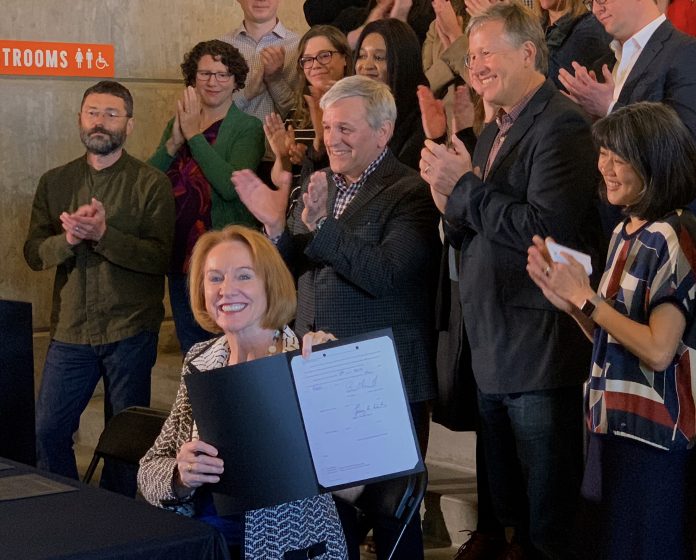
The bills’ signage marks the end of a long fight by housing advocates to get affordability requirements enshrined in Seattle law.
Before a crowd of enthusiastic supporters, Mayor Jenny Durkan signed legislation authorizing “citywide” implementation of Mandatory Housing Affordability (MHA) into law yesterday March 20th, 2019. MHA changes zoning laws in Seattle’s 27 City-designated urban villages to allow for larger developments with more housing. It also requires that new development include rent-restricted affordable homes (ranging from 5% to 11% of units depending of the intensity of the upzone) or contribute to a City fund for affordable housing. The Seattle City Council passed the legislation unanimously on Monday.
The bill will take effect in thirty days.
Instead of Seattle City Hall, the signing ceremony was held at 12th Avenue Arts, an arts center and nonprofit housing development built by Capitol Hill Housing that offers 88 apartments affordable to working families.
One of the original residents of 12th Avenue Arts, a Russian immigrant whose fashion designer wife immigrated to the US from Korea, spoke of the importance of affordable housing for preserving Capitol Hill’s culture of creativity and diversity. “Here we have a lot of musicians, artists, and… writers,” he said. “All these people would not be living here without this building. The very reason why this area is interesting is because it attracts these people… without us, we would not have Capitol Hill.”
The importance of increasing both housing capacity and contributions to affordability in order to retain diversity in Seattle was also referenced by Mayor Durkan, who said:
We make sure we do what we need to do create a city that is welcoming, increases diversity, pays attention to racial diversity, focuses and is centered on community, and [MHA] is a big step forward for doing that. If we want to be an equitable city, that city of the future and opportunity, we have to make sure that all people are not just welcome here, but can live here.
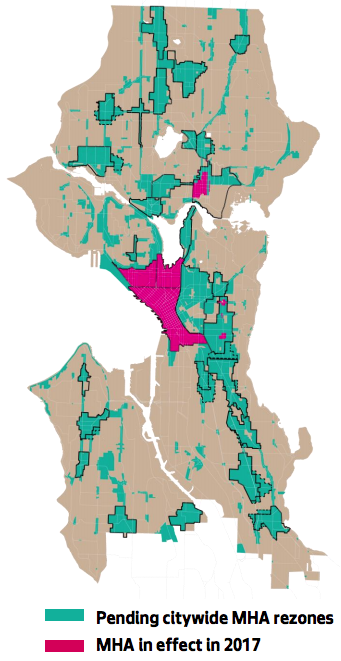
Speakers at the event acknowledged that it had taken years of effort by a consortium of government, nonprofit, and business partners to bring MHA into being.
Among the nonprofit partners, Seattle for Everyone, whose steering committee has met every Friday morning at 8am for the last two years, was singled out for its efforts, as were the 28 members of the HALA committee led by Faith Pettis, and Councilmember Rob Johnson, who led the MHA City Council Special Committee, was recognized for attending “hundreds of focus groups and [community] meetings.”
During his remarks, Johnson, who is not running for reelection, joked that there were actually about “six thousand people” who should be signing the bill into law, a reference to broad community engagement process that guided MHA’s creation.
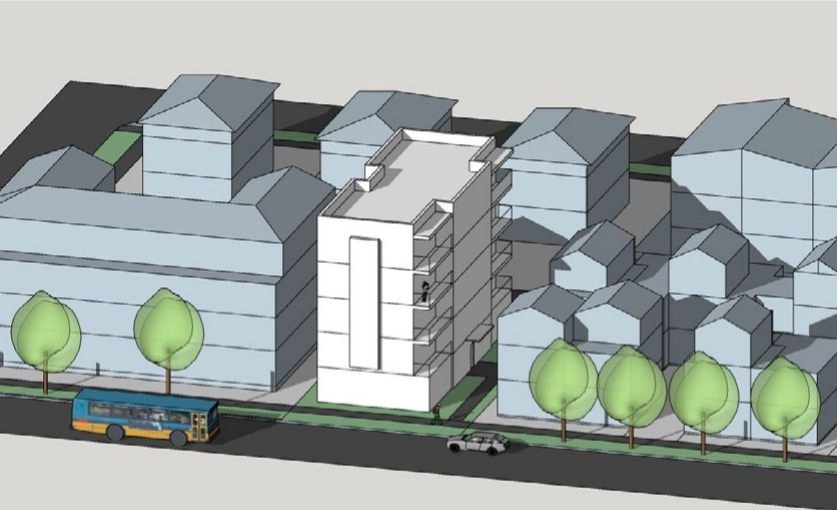
Not all would agree with Johnson, however, about amount of community engagement that shaped MHA. Marty Kaplan, president of the Queen Anne Community Council, wrote in a recent Seattle Times editorial that the MHA process had “railroaded” MHA forward without sufficient public input from the public.
At the final City Council vote, Councilmember Sally Bagshaw openly criticized Kaplan’s depiction of the MHA process, calling out mistruths in the editorial, such as Kaplan’s assertion it would end single-family zoning.
“We are going to retain 94% of single-family zoning,” said Bagshaw, who said that inaccurate information spread by those opposed to MHA, included the Seattle Times Editorial Board, had made her “grumpy.”
MHA is a “significant tool” but more reforms are needed
The fact that MHA will retain approximately 96% of single family zoning is viewed by some housing advocates as a weakness of the legislation.
In her remarks Mayor Durkan acknowledged that MHA was created as a compromise between different stakeholders and as a result did not leave any party feeling one hundred percent satisfied with the end result. Nevertheless, she asserted that MHA was a crucial step forward.
“We know we have to build into the future,” Durkan said. “While this is not going to solve all of our problems, not having this tool would be a significant setback.”
Councilmember Lorena González, who was not present at the bill’s signing, has stated that because it does not impact the major of single-family zoned land, it is not truly “city-wide” legislation. González, who Johnson joked should receive an honorary master’s degree in land use planning for her hard work on the fine details of the MHA zoning changes, has been outspoken both as an advocate for MHA and as a critic of its limitations.
During her remarks leading up to the vote, Councilmember González gave a stirring speech in she read directly from racist neighborhood covenants that prevented people of color from living in many Seattle neighborhoods unless they were employed as a domestics by white households.
“They were keeping out people like me,” said González, in reference to her Mexican heritage.
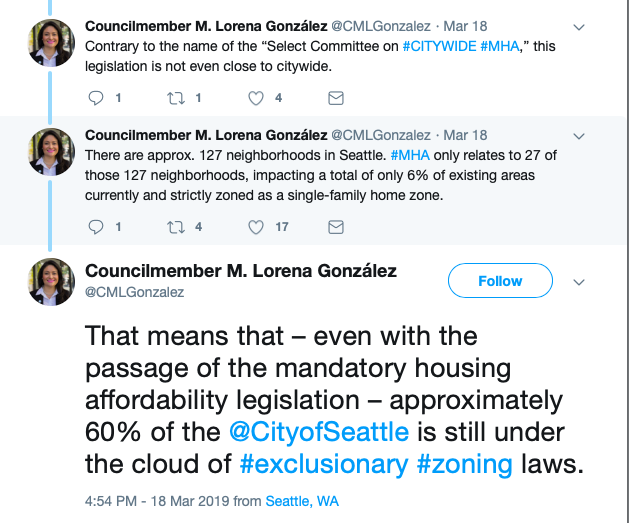
Councilmember Teresa Mosqueda, who is also Latina, referred to Seattle’s history of redlining and racially restricted covenants in her remarks as well. Mosequda passed out a handout to the crowd showing how the amount of single-family zoned land have remained unchanged over time in Seattle.
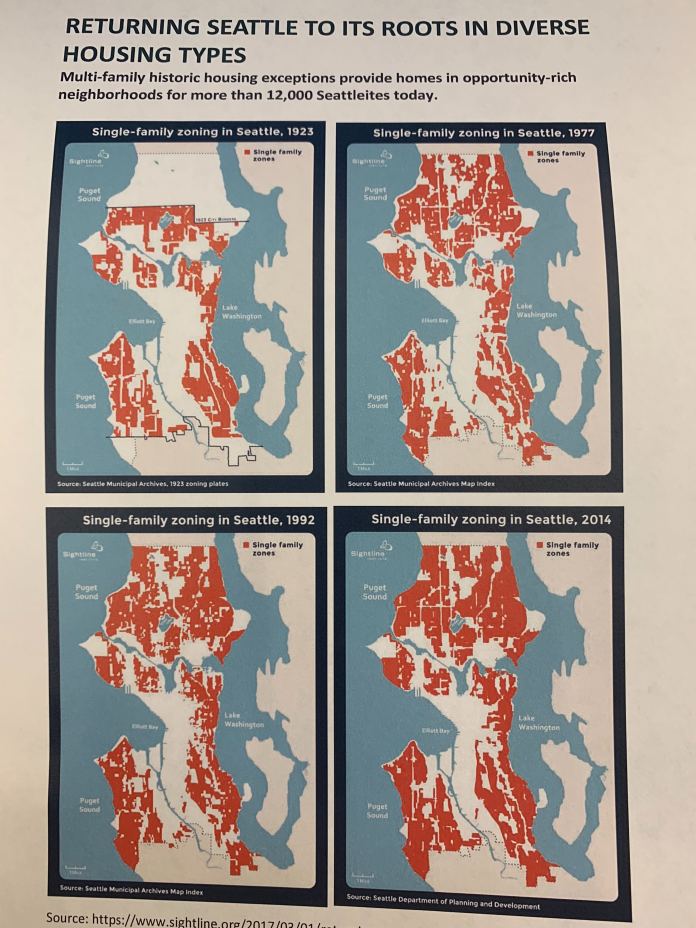
Last year the Council approved Mosqueda’s request that a race and equity analysis of Seattle’s residential zoning practices be undertaken. The results will be used to further understand how the legacy of exclusionary zoning in Seattle has led to race-based disparities in the city.
Further roadblocks may slowdown MHA implementation
The homeowner activist supergroup SCALE has already stated the intention of appealing MHA a second time. Although, they have published on their website that they are considering an appeal under the Growth Management Act (GMA), SCALE’s legal adviser Toby Thaler refused to comment on how they plan to use the GMA to structure their appeal at the press conference the group called. Sarajane Siegfried, another member of SCALE, acknowledged that an appeal under the GMA would be “very different” from their previous appeal of the Environmental Impact Statement (EIS), but also failed to provide any specifics.
The group will have sixty days after the bill is signed into law to appeal.
Developer lobbyist Roger Valdez, who has long opposed MHA’s affordability requirements, has publicly stated his intention of appealing MHA and has begun fundraising to do so under his latest front Seattle For Growth.
However, it remains to be seen if either group will be able to put forth an appeal that will gain legal traction (especially given the City’s conservative approach to inclusionary zoning). Patience Malaba, of Seattle for Everyone, is hopeful that the City’s thoroughness in drafting the plan and defending the previous of appeal of the EIS will protect the legislation from further appeals.
In addition to a second appeal, SCALE has also set its sights on the 2019 Seattle City Council election. The group is currently fundraising for candidates that oppose MHA and other zoning changes to increase density.
Natalie Bicknell Argerious (she/her) is a reporter and podcast host at The Urbanist. She previously served as managing editor. A passionate urban explorer since childhood, she loves learning how to make cities more inclusive, vibrant, and environmentally resilient. You can often find her wandering around Seattle's Central District and Capitol Hill with her dogs and cat. Email her at natalie [at] theurbanist [dot] org.

